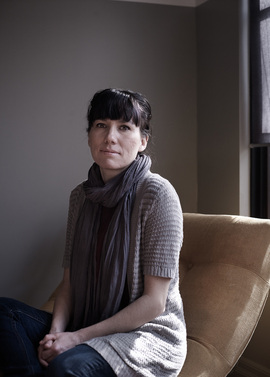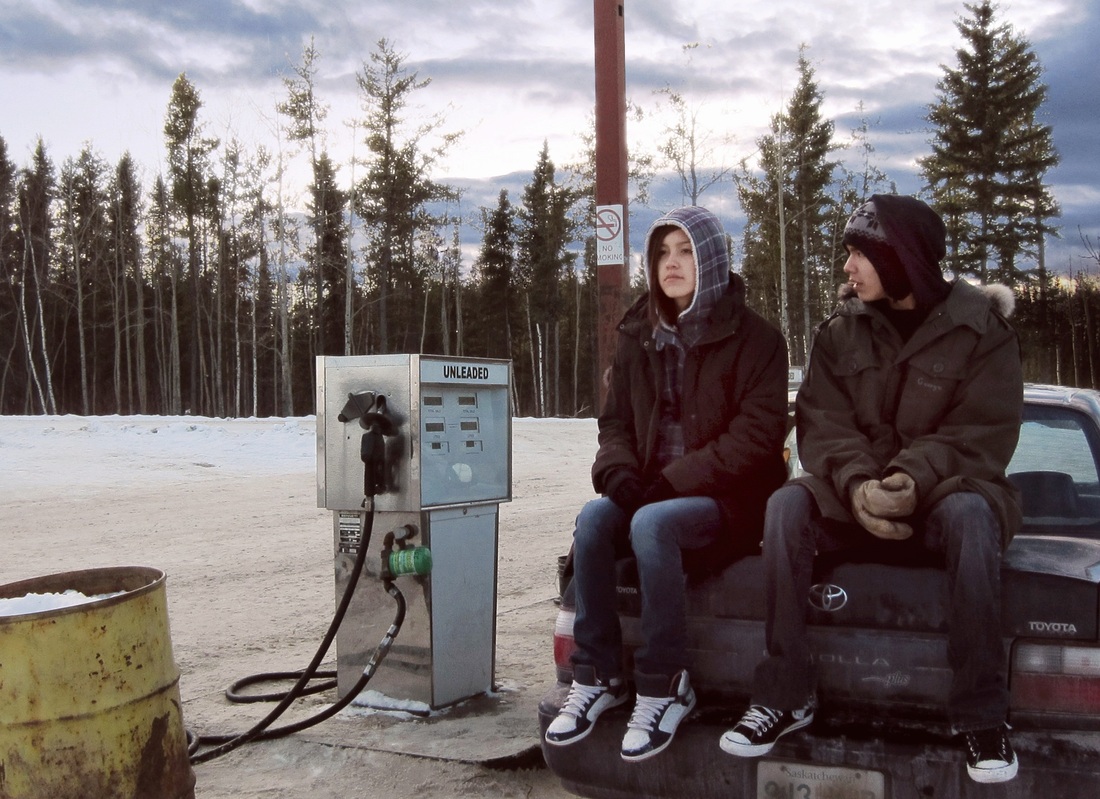RUSTY TALK WITH DANIS GOULET  Danis Goulet Danis GouletPhoto by Clay Stang Award-winning filmmaker DANIS GOULET'S short films have screened at festivals around the world, including Sundance, the Toronto International Film Festival (TIFF), Berlin International Film Festival, imagineNATIVE and Aspen Shortsfest. Her film Wakening (2013) had its world premiere before the opening night gala film at the 2013 TIFF, itsinternational premiere at Sundance and went on to win the Outstanding Canadian Short Film Award at the 2014 ReelWorld Film Festival. In 2012, her film Barefoot premiered at TIFF and was also recognized with a Special Mention from the 2013 BerlinInternational Film Festival Generation 14plus international jury. Her work has been broadcast on ARTE, CBC, Air Canada, and Movieola. She is an alumnus of the National Screen Institute’s Drama Prize Program and the TIFF Talent lab. Danis (Cree/Metis) was born in La Ronge, Saskatchewan and now resides in Toronto. Michael Vass When did you first become interested in films, and how did you get into filmmaking? Danis Groulet: I've been interested in film since high school, and I started off working in casting on films like Mean Girls and Love That Boy. After a few years, I began to experience a growing disillusionment with the projects that I was hired for. As a young Cree/Metis woman, I was becoming more and more aware of how pervasive the misrepresentation and under-representation of Aboriginal stories and characters on screen was in all aspects of the screen industry. Shortly after I moved to Toronto from Saskatchewan, I found myself in an audition room for a big US television pilot. The opening scene was an Indian Princess who silently sacrifices herself over a waterfall. That day, the most talented Aboriginal actresses in the city, who I greatly admired, were called in to audition. One by one, they walked into the room, and instead of being given an opportunity to shine, they were literally silenced, reduced to a re-enactment of a noble sacrifice. I still remember the powerful image of their faces in silence. As the casting session continued, I sunk deep into my chair in shame at the thought that I was the person behind the table, supposedly representing part of the team putting this out into the world. Spurred by that experience, the penny dropped for me: we had to make our own films. I wish I could say that directing had always been a calling. But it was more of a sense of feeling implicated to try because there were so few Indigenous filmmakers out there around that time. In 2003, I made my first short film spin and absolutely loved everything about the process. I also attended my first imagineNATIVE Film + Media Arts Festival. By the next year, I was running the festival and was immersed in the Indigenous film community. MV: Is there a filmmaker or writer (or more than one) that has been a particularly significant influence on your work? DG: I think for Barefoot, I was profoundly influenced by the films of Andrea Arnold. I still remember completely freaking out after seeing her short film Wasp at Sundance in 2005. Her films are brave and uncompromising, led by female characters who also seem to be enigmas onto themselves. I loved Red Road as well. MV: What is your favourite part of the filmmaking process? DG: The adrenaline of shooting. I love the choreography of all of the elements and the immediacy of it. It demands that you completely face every moment with your eyes as open as possible. The closest experience that comes to it for me is being in labour! MV: Where did the idea for Barefoot come from? DG: I saw my little cousin's Facebook update that said: "At 21 weeks, your baby is about the size of a carrot." This is how I found out that she was pregnant, and she was in her last year of high school. The film is set in northern Saskatchewan where I was born and spent my childhood. My cousin's update got me thinking about how normal it is for many Aboriginal women to have kids at a younger age. There are very few options for girls growing up on the reserve and they face incredible challenges. It is logical to me that motherhood would be seen as a great option for a young woman. It was important for me to situate the film from the perspective of a girl who wants a baby more than anything else and sees this as her future, and outside of the values of a more mainstream middle class perspective that might judge teen pregnancy. MV: In Barefoot, and in other films, you have used non-professional actors—can you talk about why? How is the process of casting, rehearsing, and directing non-professionals different from working with experienced actors? DG: I started in casting, so have always had an enormous respect for actors and the importance of performance to any film. However, at some point, I decided that I wanted to move away from all of the filmmaking "shoulds" to just experiment with the process and see what might happen. Working with professional actors was a golden rule for me, so deciding to work with non-professional actors was a way to break one of my own golden rules to see what would happen—and it was incredibly liberating. With non-professional actors, you still ultimately need to find performers, and I can honestly say that all of the non-professional actors in my films (including some members of my own family) are fantastic performers. In Barefoot, we also built a huge amount of rehearsal time into the schedule. We did five days of rehearsal and five days of shooting—which is a huge rehearsal ratio for film. We chose ten teens out of 200 from northern Saskatchewan to work with us for five days, and we cast the leads on the 4th day of rehearsal. I worked with a couple of experts in Forum Theatre, Warren Linds from Concordia and my mom Linda Goulet who works at First Nations University. They used theatre methods to work with the kids for the first three days, and it was incredibly powerful. I ran quite a lot of improve—we didn't really rehearse any scenes from the script but focused more on opening up and becoming comfortable with the process and with one another. We also had an Elder present for the whole rehearsal, Ida Tremblay who plays the grandmother role in the film. The kids went through a lot over those five days, and they all had a lot going on at the time. Her presence was important to the film, it made the kids feel safe, and they could talk to her at anytime if they needed to. MV: What are you working on now? DG: I'm writing my first feature, which is set in a dystopian future. I'm hoping to get my next draft off before Christmas. I'm also planning to shoot another short film set back in my hometown (same as Barefoot), but this time in the 80s at the rollerskating rink. It's based on my summer grade five crush on the skinny guy from the far reserve. I'm not sure how much hairspray will be used in the making of the film, but I'm pretty sure that it will be a lot. WATCH DANIS GOULET'S FILM BAREFOOT |
| About Barefoot In a tight-knit Cree community in northern Saskatchewan, sixteen-year-old Alyssa’s plans to become a mom begin to unravel. To learn more about this film visit the Barefoot website. |
Michael Vass is filmmaker and writer and a regular contributor to The Rusty Toque.
Rusty Talk
Rusty Talk Editor:
Adèle Barclay
The Rusty Toque interviews published writers, filmmakers, editors, publishers on writing, inspiration, craft, drafting, revision, editing, publishing, and community.
Unless otherwise stated all interviews are conducted by email.
Our goal is to introduce our readers to new voices and to share the insights of published/ produced writers which we hope will encourage and inspire those new to writing.
Archives
November 2017
February 2017
October 2016
September 2016
August 2016
June 2016
May 2016
April 2016
February 2016
January 2016
December 2015
October 2015
August 2015
July 2015
June 2015
March 2015
January 2015
December 2014
September 2014
August 2014
July 2014
May 2014
March 2014
December 2013
November 2013
October 2013
September 2013
May 2013
March 2013
February 2013
December 2012
November 2012
October 2012
September 2012
August 2012
July 2012
June 2012
May 2012
April 2012
March 2012
February 2012
January 2012
December 2011
November 2011
October 2011
September 2011
August 2011
Categories
All
Activist
Adele Barclay
Alex Carey
Alex Leslie
Amelia Gray
Andrew F. Sullivan
Ania Szado
Artist
Author
Bill Bissett
Bob Kerr
Bonnie Bowman
Brian Joseph Davis
Carolyn Smart
Cartoonists
Catherine Graham
Children
Christian Bok
Comedians
Cornelia Hoogland
Daniel Zomparelli
Danis Goulet
David Groulx
David Hickey
David Whitton
Dina Del Bucchia
Directors
Documentary
Editors
Elisabeth Harvor
Elizabeth Bachinsky
Emily Schultz
Erin Moure
Experimental
Fiction Writers
Filmmakers
Francisca Duran
Gary Barwin
Glenn Patterson
Griffin
Griffin Poetry Prize
Heather Birrell
Hoa Nguyen
Iain Macleod
Illustrators
Interview
Ivan E. Coyote
Jacob Mcarthur Mooney
Jacob Wren
Jacqueline Valencia
Jane Munro
Jeffrey St. Jules
Jennifer L. Knox
Julie Bruck
Karen Schindler
Kevin Chong
Laura Clarke
Laurie Gough
Linda Svendsen
Lisa Robertson
Lynne Tillman
Madeleine Thien
Maria Meindl
Marita Dachsel
Matt Lennox
Matt Rader
Media Artists
Michael Longley
Michael Robbins
Michael Turner
Michael Vass
Michael V. Smith
Mike Watt
Mina Shum
Mira Gonzalez
M. NourbeSe Philip
Monty Reid
Musician
Myra Bloom
Nadia Litz
Nonfiction Writers
Novelists
Patrick Friesen
Paul Dutton
Penn Kemp
Per Brask
Performers
Playwright
Poetry
Poets
Priscila Uppal
Producers
Publishers
Rachel Zolf
Ray Hsu
Renuka Jeyapalan
Richard Fulco
Richard Melo
Rick Moody
Robin Richardson
Rob Sheridan
Roddy Doyle
Russell Thornton
Sachiko Murakami
Salgood Sam
Scott Beckett
Screenwriters
Semi Chellas
Sharon Mccartney
Sheila Heti
Short Fiction Writers
Sound Artist
Steve Roden
Tanis Rideout
Tom Cull
Translation
Translators
Travel Writers
Trevor Abes
Tv Writers
Ulrikka S. Gernes
Vanessa Place
Visual Art
Vivieno Caldinelli
Writers
Zachariah Wells


 RSS Feed
RSS Feed
